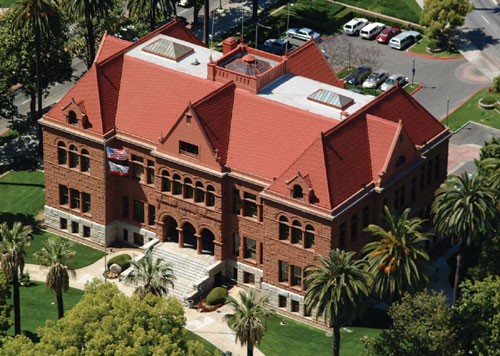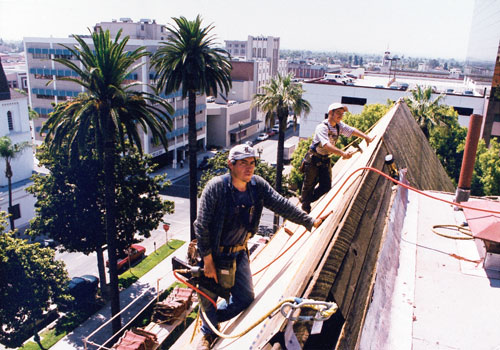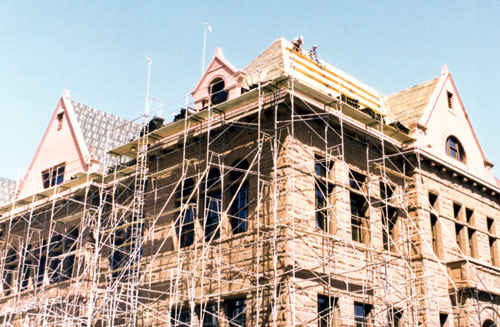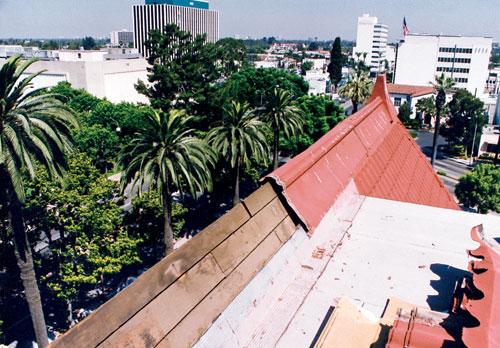Out with the old, in with the new is a common way of thinking—many people believe new things are better. The historical society of Orange County, Calif., knew it needed something better for its county court system but didn't want to get rid of the Old Orange County Courthouse, Santa Ana, Calif., which opened in 1901.
In 1969 and again in 1999, the county built new courthouses to accommodate its needs. Although this meant the Old Orange County Courthouse no longer would be filled with bustling activity, the county knew the building still had historical significance. To return the courthouse back to its original glory and make it worthy of its historical status, the city embarked on an extensive renovation project in 1983.
In August 2001, Best Roofing & Waterproofing Inc., Gardena, Calif., began restoring the Old Orange County Courthouse's metal tile roof system. To keep with the philosophy that new is not necessarily better, the company reinstalled the original hand-crafted metal tiles, which resemble mission tiles, after making deck repairs.

Photo courtesy of LaMar Photography & Video, Harbor City, Calif.
The Old Orange County Courthouse, Santa Ana, Calif., was built in 1901.
Gordon Crawght, director of marketing for Best Roofing & Waterproofing, says, "What is most surprising [about this project is that] after adding new underlayment, the original roof system was reinstalled to last for perhaps another century."
Go West
William Spurgeon, a traveling businessman, arrived in California in 1869 and purchased 74 acres (30 hectares) of land for $594. He named his land Santa Ana after the land grant name—Rancho Santiago de Santa Ana. He divided the land into 24 square blocks and sold lots for $15 each. Spurgeon's city was incorporated in 1886 and became the county seat in 1889.
By 1893, Santa Ana had about 5,000 residents and needed a courthouse and jail. Spurgeon sold land to Orange County stipulating a courthouse be built within 10 years. A jail was constructed in 1898 (where it stood now is outlined with stones in the parking lot that took the jail's place).
In 1900, C.L. Strange was selected to design a courthouse. Strange designed a three-story building of Richardsonian Romanesque style, which incorporates heavy, rock-faced stones; round masonry arches; contrasting colors; transom windows in ribbon patterns; square towers; and few fenestrations. The building has Arizona red sandstone walls and many ornate features, such as carvings in three exterior walls of the goddess of justice; scales of justice; and tracery images of leaves, flowers and animals' heads. The Old Orange County Courthouse officially opened in November 1901.
Changes had to be made when an earthquake shook California in 1933 and damaged the courthouse. As a result, a metal cupola was removed; sandstone gable ends were replaced with stucco; and fallen sandstone turrets were replaced with finials.
As the building's exterior changed, so did the interior. White and blue hallway tiles and antique light fixtures were removed; false ceilings were added; and stairs were carpeted. All interior changes later were removed to restore the courthouse to its original design.
By 1969, court no longer was in session at the Old Orange County Courthouse because a larger facility had been built. In 1979, the Old Orange County Courthouse was closed to all visitors because it was unsafe. After much debate about funding, the county embarked on a nine-year renovation project in 1983 that reopened the courthouse for some functions.
The building now is the Orange County History Center and houses archives; a marriage license bureau; chapel; museum; two hearing rooms; and the restored Superior Courtroom Department One, which acts as a museum and rarely is used for court proceedings. The courthouse also has become a Hollywood fixture. "Norma Rae," starring Sally Field, and "Gideon's Trumpet," starring Henry Fonda, were filmed there in 1979. In 1982, those filming "Frances," starring Jessica Lange, used the courthouse, and the cast and crew of the "Family Matters" television series repeatedly visited the site during the 1990s.
Historical planning
Although most renovations were complete in 1992, the county made other repairs as the Old Orange County Courthouse turned 100 years old when the Supreme Court of California held a rare session there in October 2001. County officials wanted the roof system repaired by then.
Before Best Roofing & Waterproofing could get to work, they had to appease the historical society. Specifications called for the company to reinstall the original metal tiles so the building would maintain its historical status. But Best Roofing & Waterproofing needed an alternative installation plan in case original tiles were damaged during tear-off or reinstallation. The historical society stipulated that if the company replaced any 100-year-old tiles, the replacement tiles had to match the originals perfectly.
According to Crawght, attempts to craft exact replacements were unsuccessful. After several attempts and plan proposals, the historical society agreed a two-piece tile design could be used if needed.
Preparation
The 100-square (900-m²) roof has a 10-in-12 (40-degree) slope in some areas. In these areas, roofing workers stood on toe boards and were tied-off with safety lines and harnesses. In addition, scaffolding was installed around the building in stages. Scaffolding first was erected at the building's front. Once roof system installation was completed in this area, scaffolding was removed and reassembled in the building's rear. Because of the building's historical nature and to prevent damage to the sandstone, scaffolding could not touch the building. The scaffolding, therefore, was braced with tension devices at strong points in the building, such as window ledges.

Photo courtesy of LaMar Photography & Video, Harbor City, Calif.
Roofing workers stood on toe boards and were tied-off in roof areas that have 10-in-12 (40-degree) slopes.
Each metal tile is 24 inches (610 mm) by 36 inches (914 mm), and the roof system has about 4,000 tiles. Reinstalling the tiles would have been like assembling a jigsaw puzzle. Therefore, as each tile was removed, it was numbered and stored on the scaffolding's top deck or a flat roof area.

Photo courtesy of LaMar Photography & Video, Harbor City, Calif.
Scaffolding was erected around the building but could not touch the building's sandstone.
"We were amazed at the condition of the 100-year-old tiles," says Oscar Linares, Best Roofing & Waterproofing's project foreman. "Despite their age and the fact that they were hand-crafted from galvanized metal, there was no evidence of rust."
Installation
After the tiles were removed, the five- to eight-person crew found the 1- by 6-inch (25- by 152-mm) redwood space sheathing in relatively good condition. The redwood sheathing only required minor repairs, and roofing workers attached plywood sheathing to it to form a new deck. Next, a Grace Ice & Water Shield® was installed. Then, each tile painstakingly was installed in its original position. To give the roof a fresh look, the tiles were painted with a Gaco Western elastomeric paint that matched the original color.

Photo courtesy of LaMar Photography & Video, Harbor City, Calif.
About 4,000 metal tiles were removed from the building so deck repairs could be made.
George Candella, Orange County's project manager, credits roofing workers for professionally completing the project without failure.
"The building probably looks the same as it did 100 years ago. The historical appearance of the building was faithfully maintained; each tile was replaced in the same location; and no tile replacement was required," Candella says.
After roof system installation was complete, Best Roofing & Waterproofing waterproofed gable ends and areas around the chimneys with Gaco Western products.
Glory days
In 1979, Santa Ana officials were faced with the decision of demolishing the Old Orange County Courthouse or making it safe and appear as it did in the 1900s.
Helping the city maintain the building wasn't easy for Best Roofing & Waterproofing. Realigning scaffolding to ensure it didn't touch the sandstone, numbering tiles and working on a roof slope not common in California, as well as other tasks, made the job stressful. But even during hair-pulling moments, Best Roofing & Waterproofing's crew knew it was part of something special.
Crawght concludes, "It was rewarding completing the tile replacement without losing or damaging one tile, as well as rehabilitating this gracious old building to its former glory for future generations to enjoy."
Kate Gawlik is associate editor of Professional Roofing magazine.
